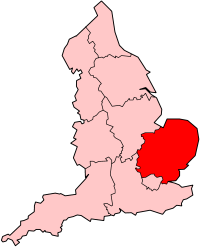Bishop's Stortford to Braintree Branch Line
| Bishop's Stortford | ||||||||||||||||||||||||||||||||||||||||||||||||||||||||||||||||||||||||
|---|---|---|---|---|---|---|---|---|---|---|---|---|---|---|---|---|---|---|---|---|---|---|---|---|---|---|---|---|---|---|---|---|---|---|---|---|---|---|---|---|---|---|---|---|---|---|---|---|---|---|---|---|---|---|---|---|---|---|---|---|---|---|---|---|---|---|---|---|---|---|---|---|
Legend | ||||||||||||||||||||||||||||||||||||||||||||||||||||||||||||||||||||||||
| ||||||||||||||||||||||||||||||||||||||||||||||||||||||||||||||||||||||||
The Bishop's Stortford-Braintree Branch Line was an 18-mile-long (29 km) line connecting the towns of Bishop's Stortford, Dunmow and Braintree.
History
The line was originally one of several schemes promoted in the 19th century, which included north-south routes connecting Great Dunmow with Epping, Halstead and/or Saffron Walden. The route of the built line was proposed by the Eastern Counties Railway in 1859, the line from Bishop's Stortford, Dunmow and Braintree was eventually built by Great Eastern Railway who had since absorbed ECR. Construction started in 1864 and the route opened on 22 February 1869. The line initially served Takeley, Felstead and Rayne with Easton Lodge being added in 1894, Hockerill in 1910, and finally Stane Street and Bannister Green in 1922.[1]
The line was almost entirely single track apart from at Bishop's Stortford, Dunmow, Takeley, Rayne and Braintree where there were passing loops. Goods sidings were provided at Hockerill Halt, Takeley, Easton Lodge (for supply of US Air Force bases at Stansted and Easton Lodge), Dunmow, Felsted (for general, and use of sugar beet factory) and Rayne.
Major features included a viaduct crossing the River Chelmer to the south of Great Dunmow which was demolished in the 1970s to make way for the A1256 Great Dunmow bypass.
Passenger numbers were at decent levels when the line first opened, but increasing competition from bus and road transport meant trains were running almost empty near the end of its serving life; it closed to passengers on 3 March 1952. The line remained open for freight until the end of 1971 before closing completely in 1972. Most of the line formation remains as the Flitch Way country park though the tracks have been taken up. It has become a favourite route for joggers and cyclists.[2]
Future developments
There have been several proposals to reopen the line but none has come close to being realised.[1]
References
Further reading
- Peter Paye, (2010). Bishop's Stortford, Dunmow and Braintree Branch. Oakwood Press. ISBN 978-0-85361-708-2.
